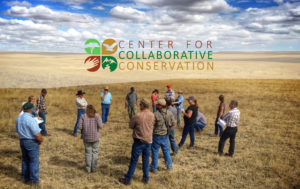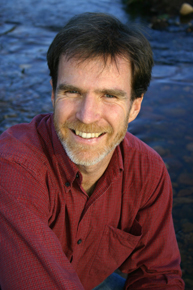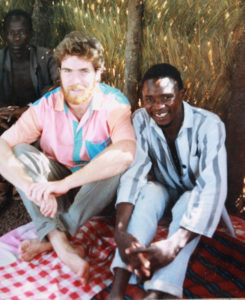
John Sanderson, the director at the Center for Collaborative Conservation at Colorado State University, is a far walk away from his aeronautical engineering bachelor’s degree. Coming from a family of pilots with roots in Montana, a young Sanderson was torn between his fascination with flight and a passion for nature. He soon realized his true calling was conservation.

“As an undergrad, I didn’t quite know where to land. I was good at math and science, but I always felt a deep connection to nature,” Sanderson said. “By the time I graduated, I knew I wanted to do something for the environment.”
The decision led him to a diverse career in conservation leading up to the director position at the CCC, a center within Warner College of Natural Resources at CSU that promotes working together to solve conservation challenges in the American West and globally.
The CCC’s mission is to build the capacity of organizations, communities, and future leaders while applying Colorado State University’s world-class research and education. Sanderson said this mission spoke directly to his education, experience and passion for sustaining the environment.
Decades in Conservation
“Leadership in this field means having a vision, and knowing how to work with people to translate that vision into on-the-ground impact.”
Sanderson’s past has bridged science, leadership and conservation. After receiving a B.S. in engineering, he went on to earn an M.S. in botany from the University of Vermont and a Ph.D. in ecology at CSU. In his 14 years at The Nature Conservancy, the world’s largest conservation organization, he became acutely aware of the unique conservation challenges in Colorado and the West. As the conservancy’s director of science for five years, Sanderson honed his leadership and administrative skills.
“Leadership in this field means having a vision, and knowing how to work with people to translate that vision into on-the-ground impact.” In leading the center, Sanderson said his goals are not only to form new ideas but to support projects developed over the CCC’s ten-year run.
“The Center for Collaborative Conservation has had a great first decade,” he said. “I aim to strengthen the pieces that have shined.”
The Conservation Fellows Program is one of those that has really “shined”, working collaboratively in 35 countries, 17 tribal nations, and including over 135 student, practitioner, and faculty fellows. The program and its impact exemplify the goals of the CCC, Sanderson said. Paralleling CSU’s Land Grant Mission, the CCC focuses on engagement with society—conserving nature and building healthy communities–while educating tomorrow’s leaders and connecting researchers to people working in the field to learn how to do collaborative conservation even better.
Addressing these challenging tasks will require him to draw on lessons from his past experiences, insights from his current conservation efforts and his ambitious vision of CCC’s future, Sanderson said.
Conservation Education: Listening to Diverse Voices
In educating tomorrow’s conservation leaders, Sanderson places high value in listening to diverse voices, which includes indigenous peoples and communities. An early lesson in indigenous perspectives came during two years as a young Peace Corps volunteer in Mali in West Africa.
“The locals knew every plant around them,” Sanderson said. “They were so aware and connected to their environment. They would say: ‘If you’re sick, use this plant or that plant, but avoid that one.’”

This is an intimate relationship with the land he sees in indigenous populations in the U.S., but their perspective has not always been considered. “Many tribes are doing a better job of managing natural resources. We must learn about their values to educate ourselves on conserving the land,” he said
Listening and considering different perspectives is essential in creating meaningful relationships that lead to lasting outcomes. Collaborative conservation is about diverse voices. It’s about engagement between cultures, and the CCC intends to expand the universe of who is in conservation, Sanderson said. “The dialogue must be broader than it’s ever been. That will be a major focus of our work.”
Research on Collaboration: A Lesson in Trust
CCC seeks to connect researchers to people managing land and water to understand how they work together most effectively. How to develop trust between parties doing conservation has been a focus of CCC research. “Poor trust is a constant barrier to conservation; getting groups to work together who may even have competing interests can be a real challenge,” Sanderson said.
An on-going research effort co-led by CCC staff is uniquely bridging conservation science and social science. The Collaborative Adaptive Rangeland Management project, based in Eastern Colorado, is focused on sustaining prairie health while managing cow herds and the economic needs of ranchers. Rangeland scientists, ranchers and environmental groups, whom often have competing needs for land, were challenged to work together on solutions.
Social scientists then studied the dynamic between the three groups to look at trust between them and how it developed over time. “The researchers learned that it takes years to build trust and understand each other, so I ask, ‘How do we accelerate the building of trust to get to conservation solutions faster?’” Sanderson said.
The CCC’s emphasis on bridging research and practice will bring together people to confront these challenges, he said.
Engagement: A Future of Global Impact
Sanderson, a pilot, admits he never completely lost his love of flight and engineering. Though he still enjoys the occasional view of Earth from above, his real passion is on-the-ground conservation—making real impact, and this is reflected in his vision of the CCC’s future.
Making an impact starts first with people, Sanderson said. As a leader, he believes in investing in the people he works with and valuing their ability. Second, he holds himself and the organization he leads to constantly learning and adapting to advance the organization’s impact.
“To me growing and learning includes not only adapting to the ever-changing needs of conservation but being curious about what’s possible,” he said. The investment in people supports CCC’s focus on impact through engagement, connecting CSU to the global conservation community.
Through CCC’s research, education and engagement, Sanderson aims to answer one question, “How do we get people to work together to do conservation that sustains nature and supports people?”
“I believe the answer to this challenge is engagement from research-driven, collaboration-minded students, faculty and researchers at CSU.”
Learn more about the Center for Collaborative Conservation at the center’s website.